Accepted Scientific Name: Stapelia glanduliflora Masson
Stapel. Nov. 16 1797 Masson
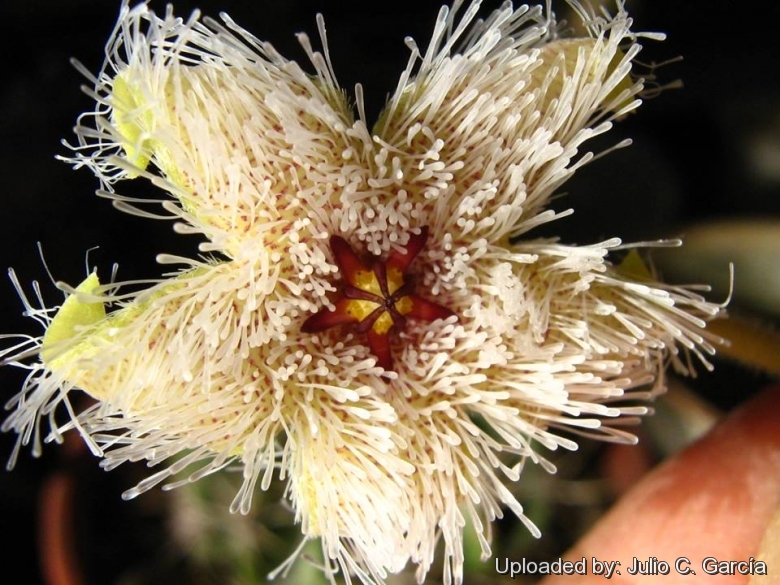
Stisseria glanduliflora (Stapelia glanduliflora) Photo by: Julio C. García
Origin and Habitat: Stapelia glandulifloraSN|28127]]SN|28127]] is known only from four locations from Klawer to about 20 km north of Citrusdal, Western Cape, South Africa.
Altitude range: 100-300 metres above sea level.
Habitat and ecology: It grows in arid, stony slopes among bushes. It has lost habitat to crop cultivation (deciduous fruit, vines, tomatoes and onions) in the past, however, this species occurs in an area only marginally suitable for agriculture, and loss is not ongoing. Remaining subpopulations however remain vulnerable to sporadic further habitat loss.
Synonyms:
See all synonyms of Stapelia glanduliflora
Common Names include:
ENGLISH: Glandular flowered Stapelia, Glandular-flower'd Stapelia.
RUSSIAN (Русский): Стапелия железистоцветковая
Description: Stapelia glandulifloraSN|30239]]SN|28127]] is known by its very handsome and highly curious star-shaped flowers clothed on the upper side with white glandular club shaped hairs. The name glanduliflora means 'acorn-shaped flower' and presumably refers to the appearance of the bud.
Habit: It is a relatively large, perennial, stem succulent that can form compact clumps 8 to 20 cm tall and up to 40 cm in diameter (or more).
Stems: Ascending square 1.2-1.8 cm across glabrous to somewhat downy. Margins beset with upright teeth. Stipular rudiments more conspicuous with age
Inflorescence: Flower stalks lateral arising at the base of the flowering stems,,downy and longer than the corolla and flatly spreading on the ground.Peduncle robust, usually button-like, some-times persistent (then woody). Pedicels purplish, 5 5 cm, decumbent. Flowers 3-9 per head opening in quick sequence.
Flowers: Sepals reaching the bases of the corolla lobes. Corolla 2.5-3.5cm across, shorter than the calyx, 5 (or more) -cleft, lobes ovate acute tawny, ca. 1.2 cm, sometimes curved outwards, outside glabrous or very weakly pubescent, inside weakly wrinkled, densely hairy, outside pale yellow-green, venation brown, inside pale greenish yellow to sulphur coloured, finely spotted with deep red dots and the bottom deep brown and clothed on the upper side with white long club-shaped glandular setaceous hairs. Corolla tube short, narrow, pentagonal, embracing the orange and black, starry corona. Outer corona to 2 mm tapered. Inner corona-lobes to 4 mm high, inner horn erect, outer wing absent. Pollinia dull orange, 0.4 x 0.6 mm D-shaped.
Similar species: Stapelia glandulifloraSN|28127]]SN|28127]] is closely related to Stapelia erectifloraSN|28127]]SN|30239]].
Bibliography: Major references and further lectures
1) Sir James Edward Smith “Exotic Botany: Consisting of Coloured Figures, and Scientific Descriptions, of Such New, Beautiful, Or Rare Plants as are Worthy of Cultivation in the Gardens of Britain; with Remarks on Their Qualities, History, and Requisite Modes of Treatment” Volumi 1-2. R. Taylor and Company, 1804
2) George Don “A General System of Gardening and Botany” Volume 4 Rivington, 1838
3) Focke Albers, Ulrich Meve “Illustrated Handbook of Succulent Plants: Asclepiadaceae: Asclepiadaceae” Volume 4 Springer Science & Business Media, 2002
4) White & Sloane. “The Stapelieae” edn 2. Abbey San Encino Press, 1937
5) James Cullen, Sabina G. Knees, H. Suzanne Cubey “The European Garden Flora Flowering Plants: A Manual for the Identification of Plants Cultivated in Europe, Both Out-of-Doors and Under Glass” Cambridge University Press, 11/Aug/2011
6) Carl August Lückhoff “The stapelieae of Southern Africa” A. A. Balkema, 1952
7) Doreen Court “Succulent Flora of Southern Africa” A.A. Balkema, 2000
8) Hermann Jacobsen “A handbook of succulent plants: descriptions, synonyms, and cultural details for succulents other than Cactaceae", Volume 1 Blandford Press, 1960
9) Bruyns, P.V. "Stapeliads of Southern Africa and Madagascar" Volume I Umdaus Press, Hatfield, South Africa Pages 257 - 259 2005
10) Leach, L. C. "A revision of Stapelia" L. Excelsa Taxon. Ser. 3: 1–157 1985
11) Sajeva, Maurizio and Costanzo, Mariangela. Succulents: The Illustrated Dictionary. Portland, Ore.: Timber Press, 1994.
12) Ernst Van Jaarsveld, Ben-Erik Van Wyk, Gideon Smith “Succulents of South Africa: A Guide to the Regional Diversity” Tafelberg Publishers, Limited, 01/Jul/2000
13) "Flowering Plants of South Africa", 12: 467 1932
14) Werner Rauh “The Wonderful World of Succulents: Cultivation and Description of Selected Succulent Plants Other Than Cacti” Smithsonian Institution Press, 1984
15) Helme, N.A. & Raimondo, D. 2007. Stapelia glanduliflora Masson. National Assessment: “Red List of South African Plants” version 2014.1. Accessed on 2014/07/21
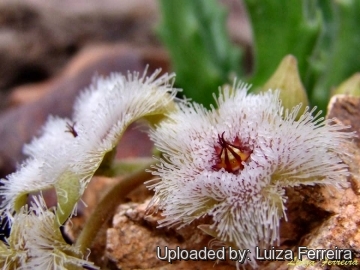 Stisseria glanduliflora (Stapelia glanduliflora) Photo by: Luiza Ferreira
Stisseria glanduliflora (Stapelia glanduliflora) Photo by: Luiza Ferreira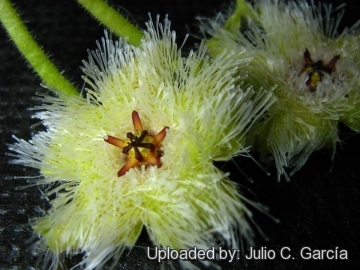 Stisseria glanduliflora (Stapelia glanduliflora) Photo by: Julio C. García
Stisseria glanduliflora (Stapelia glanduliflora) Photo by: Julio C. García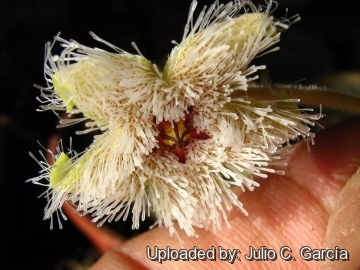 Stisseria glanduliflora (Stapelia glanduliflora) Photo by: Julio C. García
Stisseria glanduliflora (Stapelia glanduliflora) Photo by: Julio C. García Stisseria glanduliflora (Stapelia glanduliflora) Photo by: Luiza Ferreira
Stisseria glanduliflora (Stapelia glanduliflora) Photo by: Luiza Ferreira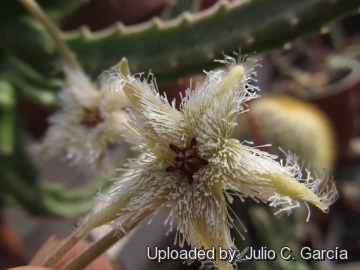 Stisseria glanduliflora (Stapelia glanduliflora) Photo by: Julio C. García
Stisseria glanduliflora (Stapelia glanduliflora) Photo by: Julio C. García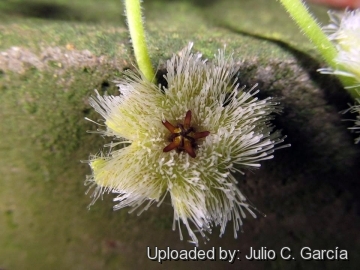 Stisseria glanduliflora (Stapelia glanduliflora) Photo by: Julio C. García
Stisseria glanduliflora (Stapelia glanduliflora) Photo by: Julio C. GarcíaCultivation and Propagation: Stapelia glandulifloraSN|28127]]SN|28127]] is an easy obliging blooming plant when mature, that it is happy in any average succulent house.
Potting:Since roots are quite shallow, use a soft and incoherent cactus mix or add extra perlite or pumice to regular soil potting soil, and clay pots help the plants to dry out between watering.
Waterings: It require moderately watering through the growing season but enjoy plenty of water and some fertiliser in hot weather, this helps them to flower freely. Water more sparingly in winter according to temperatures. But, as with most asclepiads, it is unwise to leave them wet in cold weather.
Fertilization: Fertilizers for succulent plants must be rich in potassium, but poor in nitrogen, to avoid the plants from developing excess vegetation, which is easily attacked by fungal diseases.
Sun Exposure: As with many succulents, they prefer to grow in the light shade of scrubby shrubs or between rocks where they get some shade during the day. In summer it is advisable to position this plant in a partially shady place, where it is exposed to direct sunlight only during the coolest hours of the day.
Hardiness: These plants don't like cold weather, therefore in the Spring it is best to set them outside only when the temperatures are above 15°C. Can endure temperatures below 5°C for short period, but only if the soil stays completely dry.
Pest and diseases: Stapelia species vary in their susceptibility to rotting, but are generally fairly easy to grow, especially if kept pest-free. They are very susceptible to stem and root mealy bugs, and damage from these may well initiate fungal attack. If you do have problems with a stem or with basal rotting, you can reliably isolate the healthy parts, dry them off, and re-root them in moist compost.
Cultural Practices: Re-pot every 2 years.
Propagation: Easiest with stem cuttings. Allow cuttings to dry a day before planting. Stems must be laid (Not buried) on gritty compost and will then root from the underside of the stems. It can also be increased from seeds sowing in spring in moist, sandy peat moss. Barely cover seeds. Seeds germinate quickly.

















